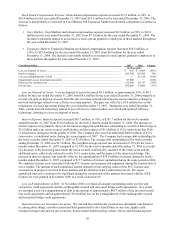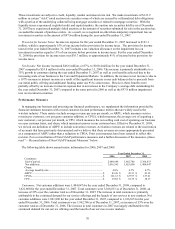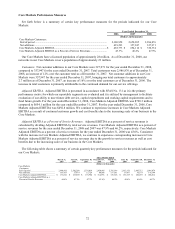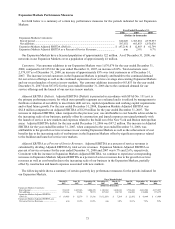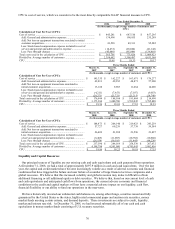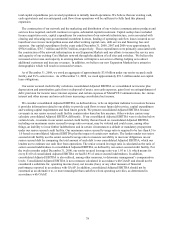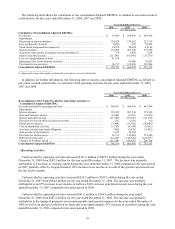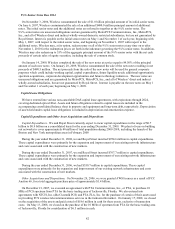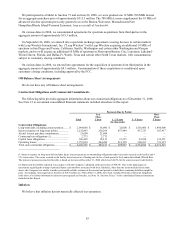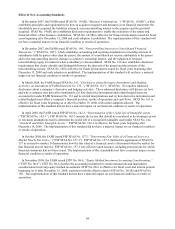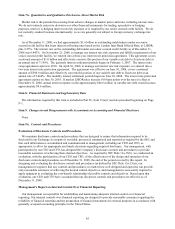Metro PCS 2008 Annual Report Download - page 87
Download and view the complete annual report
Please find page 87 of the 2008 Metro PCS annual report below. You can navigate through the pages in the report by either clicking on the pages listed below, or by using the keyword search tool below to find specific information within the annual report.78
total capital expenditures per covered population to initially launch operations. We believe that our existing cash,
cash equivalents and our anticipated cash flows from operations will be sufficient to fully fund this planned
expansion.
The construction of our network and the marketing and distribution of our wireless communications products and
services have required, and will continue to require, substantial capital investment. Capital outlays have included
license acquisition costs, capital expenditures for construction of our network infrastructure, costs associated with
clearing and relocating non-governmental incumbent licenses, funding of operating cash flow losses incurred as we
launch services in new metropolitan areas and other working capital costs, debt service and financing fees and
expenses. Our capital expenditures for the years ended December 31, 2008, 2007 and 2006 were approximately
$954.6 million, $767.7 million and $550.7 million, respectively. These expenditures were primarily associated with
the construction of the network infrastructure in our Expansion Markets and our efforts to increase the service area
and capacity of our existing Core Markets network through the addition of cell sites and switches. We believe the
increased service area and capacity in existing markets will improve our service offering, helping us to attract
additional customers and increase revenues. In addition, we believe our new Expansion Markets have attractive
demographics which will result in increased revenues.
As of December 31, 2008, we owed an aggregate of approximately $3.0 billion under our senior secured credit
facility and 9¼% senior notes. As of December 31, 2008, we owed approximately $91.3 million under our capital
lease obligations.
Our senior secured credit facility calculates consolidated Adjusted EBITDA as: consolidated net income plus
depreciation and amortization; gain (loss) on disposal of assets; non-cash expenses; gain (loss) on extinguishment of
debt; provision for income taxes; interest expense; and certain expenses of MetroPCS Communications, Inc. minus
interest and other income and non-cash items increasing consolidated net income.
We consider consolidated Adjusted EBITDA, as defined above, to be an important indicator to investors because
it provides information related to our ability to provide cash flows to meet future debt service, capital expenditures
and working capital requirements and fund future growth. We present consolidated Adjusted EBITDA because
covenants in our senior secured credit facility contain ratios based on this measure. Other wireless carriers may
calculate consolidated Adjusted EBITDA differently. If our consolidated Adjusted EBITDA were to decline below
certain levels, covenants in our senior secured credit facility that are based on consolidated Adjusted EBITDA,
including our maximum senior secured leverage ratio covenant, may be violated and could cause, among other
things, an inability to incur further indebtedness and in certain circumstances a default or mandatory prepayment
under our senior secured credit facility. Our maximum senior secured leverage ratio is required to be less than 4.5 to
1.0 based on consolidated Adjusted EBITDA plus the impact of certain new markets. The lenders under our senior
secured credit facility use the senior secured leverage ratio to measure our ability to meet our obligations on our
senior secured debt by comparing the total amount of such debt to our consolidated Adjusted EBITDA, which our
lenders use to estimate our cash flow from operations. The senior secured leverage ratio is calculated as the ratio of
senior secured indebtedness to consolidated Adjusted EBITDA, as defined by our senior secured credit facility. For
the twelve months ended December 31, 2008, our senior secured leverage ratio was 1.95 to 1.0, which means for
every $1.00 of consolidated Adjusted EBITDA we had $1.95 of senior secured indebtedness. In addition,
consolidated Adjusted EBITDA is also utilized, among other measures, to determine management’s compensation
levels. Consolidated Adjusted EBITDA is not a measure calculated in accordance with GAAP, and should not be
considered a substitute for, operating income (loss), net income (loss), or any other measure of financial
performance reported in accordance with GAAP. In addition, consolidated Adjusted EBITDA should not be
construed as an alternative to, or more meaningful than cash flows from operating activities, as determined in
accordance with GAAP.



